Blog Archive
Sunday, November 19, 2006
A visit to Namco Bandai. I want to move into the gundam egg.
This is the first game that is implemented for it. The hall where it was was filled with different arcade mashines. That is to me a whole new area, since the arcades are not that big in europe. In order to test the games Namco Bandai has an arcade hall where they do the usertesting of the game. Design wise the process have changed over the last twenty years for Namco Bandai from first designing for the arcades and then make versions for home use (when home computers and consoles were rare) to today when the versions are designed simoultaneoulsy. The framerate in the egg was so fast that i didn't feel sick at all after playing. I compare that with a production that was made at a game company where i worked in 2001, that was done for 3d glasses. We had to take turns testing it since one wanted to vomit after approx five minutes. This was different! This was good! I'm not sure how much I can say so i stop here. But i want to move into an egg!
A few more pictures
Saturday, November 18, 2006
Dirge of Cerberus
Fun and/or poetic - Bablefished emails
"The rubbish throwing away of student quality was done. It has left with the way, annoyance we applied."
Tuesday Seminars at Nakajima/Saito Lab, Titech
Goodbye Libraries, goodbye time.
I just needed to face it. Log4cxx leaks memory. Libxml is redundant when i use the bettermudserver. It was a mistake to swig down the mind. It is better to implement the mind as a lib, and rewrite the server. Goodbye several weeks of dev-time. Well - if one is to change course its better to do it late than never.
Friday, November 10, 2006
Memory leaks
One of the other things i have stuffed around with is converting my code projects from vs2003 to vs2005, and one of the problems is that the libray i use for logging, log4cxx doesnt link properly in vs2005. And there are no new binaries since 2004 in the project. ...So i thought that well either i solve the problem, or i implement a simpler logging system, or i just go on using vs2003 where log4cxx works. But now i have one of those days where i couldn't concentrate on anything, so i thought why not instead use the time to remake the logging system. That's at least a comprehensible task.
...and ended up trying to solve the problem anyway - I'm so fond of the library so i think there is a case of separation agony.
In the midst of this though i stumbled on long threads about memory leaks! In log4cxx!
what if what if...
it would be too good to be true. Probably it's not true, i have probably been sloppy and have to mend those leaks anyway. But maybe there will be one less!
Otherwise it is still good in Tokyo. I had my husband visiting last week and this week i have had a flue, but im starting to feel better.
Saturday, September 23, 2006
Tokyo Game Show Day 2

Today, which was a public day, was more fun than the business day yesterday. There were more people, and there were dancing! And cos-play! And I took some time for trying out games.
I EARNED this trinket! The platformer R-man has kick-ass game play.
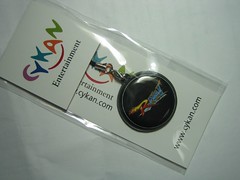
On the subway on my way to TGS today I decided upon three things to look for: MMO related stuff, booth-hunks and cosplay. (Cosplay is when people dress up to look like game characters.) I did bad on the booth-hunks, didn’t understand the Japanese information about the MMOs shown, but the cosplay was a feast.
One of the few booth-hunks:
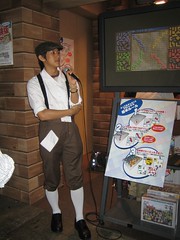
Cosplay
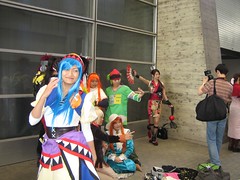
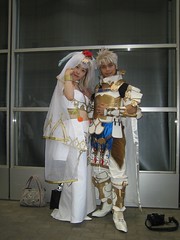
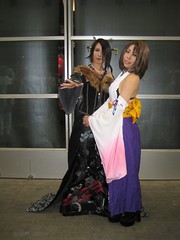
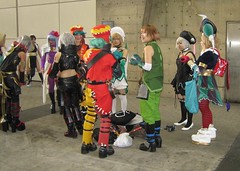

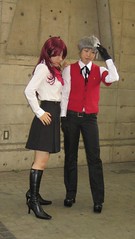
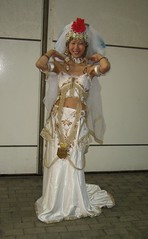
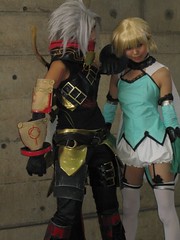

Here are all the cosplay pictures.
Here are all pictures I took at the Tokyo Game Show.
Tokyo Game Show day 1
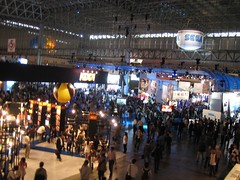
High lights:
The Eye of Judgement for PS3.
A board/card game using the eye toy. Really cool. A girl in the booth demonstrated it and it was very responsive. Fun that the eye toy is used for enhanced board-game type of stuff.
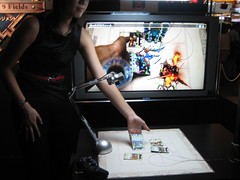
Final Fantasy XIII.
Beautiful. The story set-up seem to be the classic for the FF series. Lovely. I saw the videos in the “Closed Mega Theatre”. The screen shots I have seen on gamespy, gamespot etc doesn’t do it justice.
Pink PSP.
Seeing this awakened the same type of obsessive compulsive “I have to own” feelings that hello kitty stuff usually create. I hope I can get the PS3 in pink.
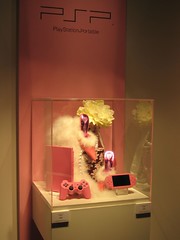
Generally
- I was surprised to not see many games using input devices requiring physical action, such as dance mats etc. Maybe tomorrow.
- I was impressed by the games made for mobile phones.
- There was a dedicated area to game schools; there are a lot of them in Japan. I went around the area asking for information in English to bring home, but the only one I found was from the Tokyo University of Technology. Anyhow, the map below shows who gives courses about games, so that should be a good base for a web search for those interested:

Misc:
Square-Enix shopping! I’m now the proud owner of some posters a t-shirt and an FF ring!


My favourite booth girl, featuring FF Online:
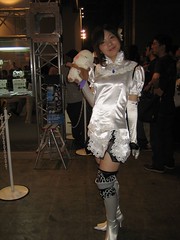
To my surprise, in the middle of the hustle and bustle of the show, I was hit by an almost religious feeling of the greatness of games. Games being, in my opinion, the greatest art form of them all, using all other art forms at the same time plus adding the skills and passions of the players. It may seem a pompous thing to write, but after all, since I have dedicated the last six years of my professional life to games I’m glad I still have this feeling.
There is much more to say about TGS06, but I'm off to the show now, I'm curious about the cos-players that will be there today. Gamespy and Gamespot have good coverage of the show, also translating the japanese keynotes and more for us non-japanese speaking persons.
Tuesday, September 19, 2006
Arrived to Tokyo Tech
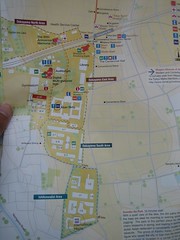
The trip here was a bit of an ordeal, but I’m suspecting that the travelling curse I seem to be affected by is loosing it’s grip! I didn’t land in the middle of a potential civil war, as I did in Beijing 1989, I didn’t end up on the wrong continent as I did 2004 in Costa Rica when I was supposed to go to California, and I wasn’t left in the wilderness without luggage and handbag as I was 2003 in the Canadian Rocky Mountains. What happened this time was that I missed my flight at Heathrow due to the time to stand in line for security checks, and that I, on my way to Tokyo Tech gave the taxi driver 30 000 yen instead of 3 000. That is peanuts really compared to what usually happens when I travel alone. But I’d better not get my hopes up, it could be bad luck and hubris, and I should touch some wood immediately. (Swedish custom that annuls bad luck due to hasty comments expressing hope.)
As soon as I got to the lab I could relax. Everyone was extremely helpful and just in a few hours I had all accounts needed, a desk, access to both the lab and the International House where I stay, had my luggage dropped of and got guided around the area! We even had time to drink coffee and chat.
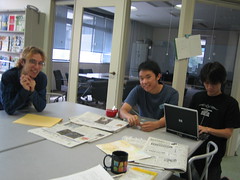
Since my arrival I have… well it feels like I have slept more than I have been awake, but in the waking hours I have been reading guidebooks. In the reading room of the International house I found a veritable treasure of literature on Japan – guidebooks, classical Japanese literature, language course book and more.
Being enveloped by a sign system that is new to me I have made a start of deciphering it by listening to pod casts with Japanese language lessons and browsing some books on katana and hiragana – signs.
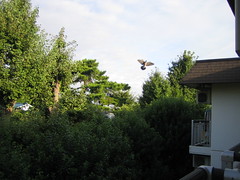
I still haven’t used the subway, but I will at least do it on Friday to get to the Tokyo Game Show.
I am probably in line for a culture shock (se phases here), but it will probably be mitigated by the fact that the lab is pretty much like labs are all over the place. The questions I asked about the daily routines of the lab when I arrived made me feel at home – it is familiar. So I can make excursions to explore Tokyo with the comforting knowledge that I can go back to the lab. Here is information about the research in the lab.
Thursday, August 10, 2006
MUDs, Reports and Marriage
The most important thing that has happened this summer is that I have gotten married! We, my husband (!) Rauno and I, decided to ignore social conventions of how to match invitation cards with handbags and god knows what… we eloped to Bali instead! So now I am Mrs Palosaari-Eladhari. If any of my unmarried friends starts to plan a wedding, my strong recommendation would be to keep quiet and book a trip to the paradase - which is Bali. Gunilla who has the travel agency organising it fixed everything - even the clothes. We just relaxed and let other people pamper us. The morning of the wedding we went diving (Rauno got his diving certificate on the trip) and then had drinks in the pool before the hairdresser, make up artist and masseuse arrived!
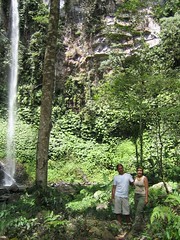
Wednesday, June 21, 2006
ACE 2006 Highlights
I took a massive amount of pictures that I posted on Flickr.
Some of the highlights included:
Lisbeth Klastrup’s “Death Matters: Understanding Gameworld Experiences”
In her approach she surveys the actual stories that players tell about their experiences of death in virtual game worlds. For a couple of years I have, when given the chance, argued that in VGW:s there is no narrative until it is told by the one that have experienced a certain sequence of events. Before that the world consists of a vast set of elements that are the base for story construction. So while listening to Lisbeth’s speech I had a warm experience of agreement. Also she has picked a particularly fitting subject of study: “death” can be both an everydayish experience in a VGW, but also a very dramatic one, depending on the context. Lisbeth said in the speech that she found while doing her PhD work that players often told each other about these experiences, so the choice of theme for the study is not only theoretically based. In order to help advance this ongoing research, please visit the project website and tell your stories. Lisbeth is onto something important here, I also find her method of working interesting (in a good way).
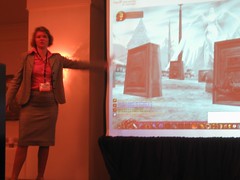
Initial Lessons From AR Façade, An Interactive Augmented Reality Drama, Steven Dow, Manish Mehta, Annie Lausier, Blair MacIntyre and Micheal Mateas.
I enjoyed this session: the team behind the paper had made Façade into an augmented reality drama, meaning that the player could move around in the staged apartment of Trip and Grace, interacting with the two virtual characters and the environment. For the more tricky AR problems that were not of the groups focus they had used OZ techniques in order to acquire results. One of the most interesting aspects was that the drama by using this became staged (association: theatre), ie that the player got the role of an actor for the other people in the room that were watching the experiment. The question the session left me was whether the experience had been a dramatic one for the player or if the novelty of the technology had had too a big impact on the experience. It will be interesting to follow how this work progresses.
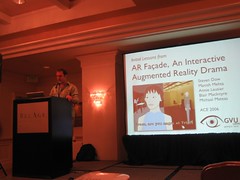
User Model in Multiplayer Mixed Reality Entertainment Applications
Stéphane Natkin and Chen Yan
Cut from the abstract:
“The goal of our research is to provide a narration model correlated to a user model in the design of mixed reality entertainment. In this paper we give a brief survey of the current researches on user model for adaptation and personalization of services and some empirical studies of user model in games and interactive narration. We propose three possible levels of the user model: generic, localized and personalized and three types of narration scheme.”
What I found most useful from their presentation was the three types of narration schemes, and the fact that they (as I perceived it) had plans of combining the three: global narration, context-oriented narration and character-based narration. And of course the mixed reality perspective made it extra interesting given my previous work with the game “Garden of Earthly Delights”.
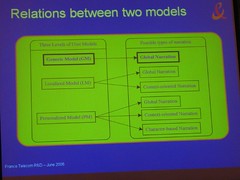
Art and Demos
Besides interesting sessions ACE2006 had organised an excellent exhibit of art work and demos. I started to dream about having a house where I had sliding interactive doors, furniture that lights the room and changes the light intensity when touched and used. The sweetest robots in the world would keep me company:



My stuff
My excuse for going to the conference was to present a short paper and poster. Elina Koivisto couldn’t make it to the conference, so I presented the poster “Paper Prototyping a Pervasive Game”:
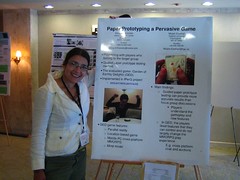
The paper I presented is called “The Soundtrack of Your Mind. Mind Music – Adaptive Audio for Game Characters”. Here are the slides.
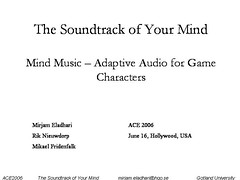
Wednesday, April 05, 2006
Vallius, Kujanpää & Manninen: Creating Role-Playing Experiences -- CASE Castle of Oulu
Creating role playing experiences – Castle of Oulu.
freeform notes from Seminar on Playing Roles in Tampere March 2006
Starting session with briefing the players. Target group schoolchildren. 12 – 16 years, age.
Social Role Play
Using historical data. Could be used for teaching historical lore.
Characters:
1. who am I
2. what is my aim
3. what threatens me
4. what do I know.
Interaction:
- interwined plots
- conflicting goals
- “shades of gray”
- non-violent.
Wanted to find out how the games was experienced by the players.
300 players. Observed while playing, and questionnaires.
30 children per session.
In the introduction they were encouraged to role play, to try it in the environment.
Challenging, many children were very used to playing to computer games, while some had no experience. Game designed to be easy to play. For experienced players the interface was unfamiliar. No violence and limited space. Nothing else to do than socializing with other players, which is what the researchers wante them to.
Talking via headphines, all ppl close to avatar could hear. But the did stand close to many people didn’t find placer where they could talk more private, instread stand in the centre.
Found out that as a role playing game the environment warnt designed well enough. The didn’t play roles so much. But for social interaction it was very sucessful. This could be used to make new iterations that would encourage rp.
They did role play in order to reach dertain goals though.
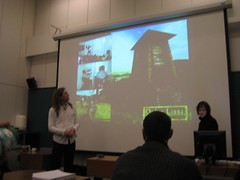
Discussion: Toni and Laura asking on how to relate to/study experience
Lisbeth: a few assumptions in the paper puzzled me. One thing is the use of real voice. Nonymity that is provided by typing can cater for playing roles. Children would immediately reconise each other.
Laura: yes, many children immediately tried to find their friends and didn’t pay much attantion to their roles and goals. But the did speak to strangers. Another limitation we had: we had 2 characters, a dog and a bird. That were played by researchers – observers. Agree that the anonymite is a bit lost by voice. Voice alteration.
Lisbeth: also the sense of having a big world: a group activity for the children could be to explore the world.
Laura: We wanted them in a small space the same, so they could gather knowledge and clues form each other. Could try exploration in larger world in another iteration. For this game it was more realistic to keep them inside the castle.
Craig: I wanted to say something about voice communication as well. Natural voices, what happen to immersion, and the need …
Laura: but would that prevent you from playing a role?
Craig: natural and modified voices doesn’t seem to work so well.
Laura: I don’t think it is the voice thing that prevents the role play. A female can play a male in a larp for example. Change of attitude.
Frans: that need to be trained.
Tomas (danish psychologist) How did you advertise/inform about the game.
Laura: brief, and during play > acceptance of the rules of the particular game.
Tony: afterwards they would get info compiled by the teachers.
Montola: Henry Jenkins “Revolution” Never winter nights. Pre civil war, slaves. Intersting to have a look at. MIT.
Red t-shirt: did you actually prepare the players for the role play – how to do?
Laura: yes even before we built the prototype we designed the brief. But not given a lengthy explanation.
Red t-shirt: isnt it unreasnobale to expect that they would know what to do and how?
Laura: the rp was only a small part of the research. Now when we have the prototype we can start implementing rp elements if that is the way we chose to go.
Monday, April 03, 2006
Svahn: Brainwashing is Fun!, freeform notes from Seminar on Playing Roles, Tampere
Svahn: Brainwashing is Fun!
Ist: debating contest, Flood and Pohjola up on stage.
Mattias giving them a standpoint each.
After debate: (which was really fun, now laughingmuscles are tender),
Mattias sais that he is not interestid in the audinces view on the points but on what happened inside the ones doing in the debate.
Janic & Kings experiments. People convincing themselves when publicly playing an advocate for something. The more imrovisation the more persuation.
Korean prisoners of war.
Slogan contests
Contingency exercises.
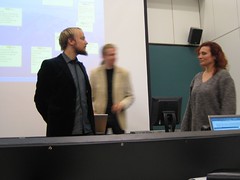
Discussion,
Mattias asking: could this be used for game design?
Like
Public commitments?
Small rewards?
Would this work within a magic circle?
Mattias saying he is thinking of maybe testing it in for example in a mmog or in a tabletop.
Craig: interesting question, re discussion yesterday re the cathartic functions, when an experience starts and when its over. Clear signs if being in a magic circle or not. Strong boundary perspective could... //i didnt get the rest
Lisbeth: is the stake here to also develop a set of rethorics of persuation?
MS: hmm interesting havent thought about classical rethorical methods.
Craig: Steffen Waltz, doing research on rethoric things. Also tells about a car-convincing-thingie in germany.
MartinE: Classic qusetion: does rp make you mad? Are we changed by it? Affected or affectors? Bit of a tabu. Other emerging intersting thing is to work with reversed kathartic thins,. Like playing a nazi or playing in hierarchical structures, strict: that could (or is supposed to) have the opposite effect, to see things that maybe is inside ones own person, playing the enemy, and then when it is over be able to see the mechanisms, to understand them.
Harviainen: series of playing neonazi, fundamentalistic protestantism etc and then discuss how it was trying to understand it.
Flood: i echo. People having troubles roleplaying characters in structured environments, players learning to become social. Partially conscious. Actual change in behavior, maybe not being so consious about that.
Petri: ppl often do drastic misdjudgement on how they think that they will behave in an actual situation. An arena for self-reflection.
Stenros: Does role playing a lot make people more flexible in real life, or more difficult to persuade?
MS: no idea lets keep discussing via email! Difficult to find long term studies, so i can only give my personal reflection: That the personality may become more rich/complex by these experinces.
...hot and cold acting...
Flood: it could be interesting to do a long term survey.
Lieberoth: Drawing on the Canvas of Imagination. Role-playing Games and their Relation to Social and Semantic Knowledge, freeform notes from Seminar o
Lieberoth: Drawing on the Canvas of Imagination. Role-playing Games and their Relation to Social and Semantic Knowledge
Cognitive science.
Mental and public representation.
decoupled thinking (cosmides & Tooby 2000) thinking about thinking.
Sharing minds
Sematics and formats.
Must realise that not all can be shared.
Pooling of sanctioned knoweledge.
Clashing individual representation (piaget)
Mental imagery and sharing and information //montola's paper approaches from other angle, interesting, information sharing and subjective worldvies that never can be exactly the same.
//Lieberoth should be infromed about the call for positions in FUGA.
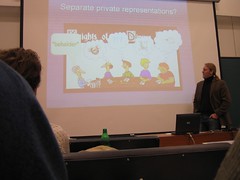
Lisbeth: what about graphical computer games, what happens then? (his example in the presentation was a table top game)
L: like in mmog's are exremely fixed imposed mental representation, fixed.
Liz: but they are still representation, while in a larp a thing is what it is.
L: its the same thing running around in the woods, its still imagining
Craig: thats a crucial distinction. Still a lot is through text, when having visual representation. Problem for computer rpg, loose the imaginative elaboration.
Flood: asbergers syndrome
L: yes have been searching!
Montola: defining and redefining the world, do you agree?
L Yes.
Petri: diagree with the diss of using imagagery, it doesnt take away that one can imagine. Hypothetical reasoning. Need to use imagination to make something out of that too.
L: imagination constantly generative and fluid. Ability for metarepresentation. Our thinking and imagination ...
Craig: The D&D game... Many types of arbitrary monsters, belonging to a gaming world, thoughts on that?
L: peer learing etc etc and then went into a reasoning about structures to remove roles that impose whole cultural concepts.
//discussion about representational dissonance.
Montola: i think visualisation isnt that important as one normally think.
Henriksen: Educational Role-Play: Moving Beyond Entertainment, freeform notes from Seminar on Playing Roles, Tampere
Henriksen: Educational Role-Play: Moving Beyond Entertainment
Games as a content provider and feedback mechanism.
The perspective model.
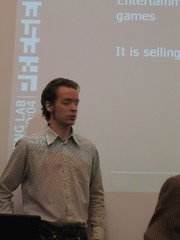
Lisbeth: How do you see entertainment?
Henriksen: hard fun... //i didnt get it all its morning. Lazzaro stuff.
More relevant learning if stepping out.
Craig: but if it isnt fun, whats the reason to use game, why would ppl engage?
H: the ppl using these have a primary motivation for learning, not entertainment.
C: you make a classic misstake... Games might not be appropriate for a learning processes. They might not be good as learning environments.
H: Well, I can get a skill to become very good at using a paper sword. (pointing at a slide)
C: games as // I missed out on the arguments while trying to work out whether there really is a fundamental conflict here.
Flood: play as tool?
H: deconstructive approach > frustration as main motivation (pointing at a slide reminding on the flow diagram)
MartinE: do you break game in middle "what have you learned now" (after introductory sentences about immersion, magic circle, immersion in larps)
H: not really... Debriefing: interesting practice.
Montola: what type of knowledge do you teach people?
H: doing things in new ways
Harviainen: Im in agreement here taking out the entertainment thing, emphasising the ... //well its either and interaction model or a process they mean here, im not sure.
Stenros: can step away for moments, that is already there, it can be there without taking out the fun.
H: two models here not confuse. Hard problem -> solving etc is in stages, then other model to use breaks. //i think he said so
Lankoski: Playing a Character: Role-Playing and Pretence Play, freeform notes from Seminar on Playing Roles, Tampere
Lankoski: Playing a Character: Role-Playing and Pretence Play
Sceptical to the janet murray thing of immersion, the general thery of rp experinces.
"you can't escape your body"
Studies about childrens imaginative play.
A lot in common w role playing.
Rping a more sophisticated form of childrens pretence games.
Goals and role play.
Difficult to role play without some kind of goal.
//Interesting that he relates the layers of goals to different emotions (in the player i presume)
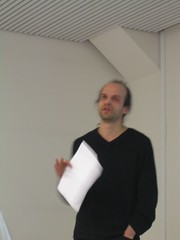
Discussion
Craig: this reminds me of a paper in the last knutpunkt book, some danish psychologist: ppl shouldnt act out it keeps them in a childish state.
The danish psychologist popped up in the audience: Huh? Whats the question?
Craig: would you see prtetence play in all modalities of larping?
Petri: yes, but different types of decisions, different ways of filling in blanks. No generlaization possible.
Craig: ...what about player types.
Petri: all players. Common things needed. Need to be able to predict, to create imaginatary scenarios... What happens if i do this or that. All people do that. Childrens play use this kind of hypthetical imagination.
Craig: do people do that all the time? Everyone role plays all the time? Is it then particularly applicable to larping?
Petri: rping is not so special in that way, but has complex layer stuctures and compex ways of handling different situations.
...
Petri... Quasi emotions... A fear situation cant be scary if it is pretece... Petri thinks its a bit odd
//i asked about whether he maps the 3 goal layers to the emotions that are related to feeling affects depending on reaching goal or not. Petri answered in a way that made me interpret that he talks about the player emotions, relating (probably) to all three layers, but from the players perspective.
Hopeametsä: Immersion in LARP Experience: Ground Zero as Case Study , freeform notes from Seminar on Playing Roles, Tampere
Hopeametsä: Immersion in LARP Experience: Ground Zero as Case Study
Ground zero:
Bombshelter situation.
Test use of closed space.
//remember the larp martin and staffan made when we were at the castle in bonn. They documented it, didnt they?
That a character doesnt immerse in the character doesnt mean that he she isnt immersed in a game. Can be immersed in the game to put it without negations.
Flow experience.
Components of immersion.
Topics for discussion:
- Larp as a game
- Immersion
- Relationship between the player and the character.
Where is the line between the character and the player?
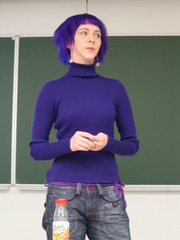
Discussion
Lisbeth: in harvainens paper says you cant learn anything if you are immersed, view on that, and what about using an american setting in finland?
Hopea: ask the players, some of them are in this room.
Harviainen: appropriating alien information was about learning things ... Outside the game... In that meaning these are not connected.
Craig: from feature based definitions of games LARP not a game, but that also depends on how players approaches a game. Ritualistic stuff, religious stuff, what kind of freezone is it? What does it give you. For playing the character a player often plays?
Martin E: not the case in this game! Have detailed characters.
Craig: the liminal function is really interesting, what is the social function.
Stenros: a player felt that the character was a hinderance, he wanted to feel the situation without that filter, but that really depends on the player. A few years ago this was seen as avant garde, when it happened, pushing boundaries.
Craig: But what kind of ritual is it.
Grey t-shirt: arousal vs frequency. Flasbub(?) learning. If putting a lot of emotion into a ritual the recall of the situation will crystallise whatever you experience. Seems to have a lot to do with arousal.
Harviainen: exellent game for study. Low quality of characters, shallow.
Hopeametsä: character were built by players in coop with game master.
Petri: no cognitive capacity left when in that immersed state. Later on one can interpret. Prelearned ways of coping. Important part of roleplaying.
//interesting that it in some cases immersion is increased without having another role. Hmm not really. Must be one of those habit things, thinking role role role if rp context
Hopea: this still work in progress, valuable comments. (re something frans said about the post-game euforia.)
Lisbeth: i dont buy the ritual thing, more towards the gonzalo frasca stuff.
# Harviainen: Defining the In-Game State: A Field Study on Player Perceptions of “Self” during Live-action Role-play , freeform notes from Seminar on
Harviainen: Defining the In-Game State: A Field Study on Player Perceptions of “Self” during Live-action Role-play
A failed field study, got less questionaires back than needed (60) //not that bad.
Character immersion: Yes. Answer rate 68%
No correlations for factors trying to find "enjoyable game"
More finns than swedes beilieved in immersion. Amount of propaganda in rp community?
Gradually becoming rather than pretending.
Signs turning to other signs (comparison: plane hijack)
Most imortant finding: players likely to choose the option with the most dramatic potential, s long as that option remains within the parapeters of character and game consistency, quote from Lehman (2005) seem true. (LARPING)
//wonder if it would be true for other genres of RPG?

Discussion
MartinE: this an ideal. It didnt happen in Moira. A lot of dramatic potential was turned down. Ppl report their ideal. Sad truth is that people can be shy and lazy.
Heidi: the qustionnaire has a quite formal language and confusing questions, that could have had an effect.
Harviainen: next thing to do would be interviews.
Sunday, April 02, 2006
Sveinsdottir: Just a Game? Production and consumption of content by role-players in Star Wars Galaxies, freeform notes from Seminar on Playing Roles,
Sveinsdottir: Just a Game? Production and consumption of content by role-players in Star Wars Galaxies
Her character could have been lvl one - her abilities did not matter at all for the roleplaying. Everything enacted, emote played instread of using the game system.
...so player driven, gamist perspective ignored.
From my notes when reading the paper:
Surprising that conflict was avoided so much. Used NPCs as bad guys. Did not use the conflicts designed into the game world.
(did the revamp have any effect on the rp:ing?)
Very group/community focussed play. Drama vs Socializing.
Most interesing with the paper to me is the focus on how important the narrative is for the community: almosed used as a tool for keeping together (the thing of creating a mutual view on the world, merging and developing subjective views)
Discussion:
Craig: a nice example of players using a ga-me world as arena for roleplaying.
Svein: they dont mix gamist and role play at all. Come together to roleplay. When asked why swg is used: can have own cities. Good custimization possibiliites.
//i would add that they have an emotesystem that is very good for rping as well.
Red t-shirt: common to separate from game world. The less of the game there is, the beter it is for roleplaying. Good in swg to make cities.
Harviainen: sounds like a new role playing game that is superimposed on swg, just using swg as a platform for another game.
Annika: isnt that very common, use a game as a playground.
//hmm how make the world support it instead
staffan: no support for guildleading/game mastering
Montola: customizability important, but not so good that one either.
Martin E: Neverwinter nights have exellent game mastering stuff, anyone looked at that
Heliö: yes.
I asked about the fact that they aviod conflict,
Sveinsdottir: yes, a lot of the players are also roleplayers offline and when asked about differences they say that the fact when playing real life, ppl cant leave the room without explaingin, but an online player can just log off. Important to keep the community.
I commented that the narrative seem like a tool for the community, and she said that yes, it is common that the story coordinators desgnes the stories to strenghten the commity does individal things for individual characters to bring them in.
Oliver: A Hardcore Oxygenarian Speed-Ascending Mall-Trading Clan-Leading Pastamancer is You?, freeform notes from Seminar on Playing Roles, Tampere
Oliver: A Hardcore Oxygenarian Speed-Ascending Mall-Trading Clan-Leading Pastamancer is You?
The kingdom of loathing.
Character class: sealclubber
...shows slides, silent, presenting an rpg
A low spec game. Everything is single player in the narrative.
Looking at roles ppl saw themselves in.
The good citizen, a phrase used by players.
Bugfinder and tester. Influencing development team.
//seems in that respect a little bit like a mud, being a wizard.
Roles in this game primarily social, getting over the rules, seeming trivial.
Experienced players defened their own roles from a social perspective, while newer players defined themeseves from the game rules, classes etc.
Aversion to typing...
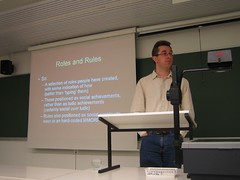
Glas: Towards a Model of Play for the Massively Multi-Player Online Role-Playing Game, freeform notes from Seminar on Playing Roles, Tampere
Glas: Towards a Model of Play for the Massively Multi-Player Online Role-Playing Game
I was so exhausted by presenting - Jenny and I presented just before Rene, so i only managed to scribble down the two following sentences:
Want to focus on play rather than motivations for play...
Liz: referring to the "Alone Together" paper.
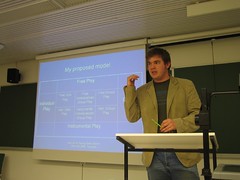
Montola: The Invisible Rules of Role-Playing, freeform notes from Seminar on Playing Roles, Tampere
Montola: The Invisible Rules of Role-Playing
Role playing as a social process.
This paper basic backbone of thesis.
States: Role Playing is Gaming.
Hasnt been done thoroughly enough yet.
Games are_.
Formal
Structued
Rule based.
Rules of rp itself?
How apply game studies to rp?
RP is interactive construction of subjective Diegesis.
Creation of own story world.
//interesting, close to Lisbet's stuff, and my stuff.
Three frameworks:
Exogenous (stems from outside the game)
Endogenous (from inside the game)
Diegetic. (resides in fictional world)
Rule 1 (3)
RP is and interactive process of defining and redefining
Rule 2 (3)
Powe to define the game worl is
Rule 3 (3)
Player-participants define game world through personified character constructs, conforming to the statee, properites and contents of the game world.
Optional rules. (5)
Rping is
Game strucute,
Power stucture
Information structure
Discussion.
Craig: 300 pages in the seventies expanding to thousands, more and more detailed, how rules are formed by conflict in the games. The gamist thing of loving rules.
Montola: and companies making money on creating more and more rules
Lisbeth: in first rule you say player can define, but in the third rule you say that the world is given.
Montola: hmm in third it is about the players i should underline it.
And in MMOGs players DO create objects and give them new meaning and function.
Liz: maybe if you add augmenting in the first rule.
Pohjola: different kicks for different groups, influential. ...but when you discuss social power, is it in the group or is it in the narrative? Could be clarified.
Blue t-shirt: game masters, do they role play if everyone is a game master?
Montola: all participant can change diegetic content, but well game masters could role play if they have a distinguashable character.
Blue t-shirt: maybe the 3rd rule could be refrased...
Annika: I am confused. Reason: you claimed that the rp experience is fundamentally subjective. What is the game world in that case if it is socially constructed by all participants.
Montola: all have their subjective view. No one can access the world as a whole.
Annika: but they are in the same world.
Montola: it is an illusion that a lot of effort is put into.
Annika: so much given in an MMORPG.
Craig: when you finish, what can you do that you couldnt do before you started?
Montola: what is role play? Distillation of the funcamental core of role play?
Craig: A canonical view we all can refer to? Or looking at AD&D page 20?
Montola: im not very practical in this one.
Green t-shirt: Is it possible to really describe social processes? Id describe Rp as social activity, I miss the social part in the paper.
Craig: a benefit of this could be forming design practice. Seeing rule sets that are not explicit in rule books. Since many players play same characters in many games maybe there could be rulesets specific to characters, as a type of characterization.
Stenros: in the papers for this conf, we have so different views of what rp is, confusing.
Craig: create languages for talking about this, fundamentally valuable. Also the process of defining is important. A definition is like a flashlight, it highlights certain things.
Harviainen: What about ... Basic template that each culture has about what for example a statue with a man on a horse is. In Finland its mannerheim, in sweden its karl. The functionality of the diegesis.
Montola: yes so different cultural templates, and we can never be sure how different they are, re the different views, the subjective, on the world.
...multiduscussion: agreement that the more described something is the more different the view.
Liz: true rules? Pretty normative, no?
Heliö: Role-Playing Game as a Guided Decision-Making Process, freeform notes from Seminar on Playing Roles, Tampere
Heliö: Role-Playing Game as a Guided Decision-Making Process
Games narrativity dialog
In multiplayer games, how social networks define that.
The immersion state that is aimed for, supposed to aim for. Heliö disagrees.
Sees RP as games, though Juul doesn't.
Goals _are_ well motivated and structured.
How support players?
Well motivated goals are crucial.
Knowledge of player expectation.
Space for both character and player experimenting.
Playing towards failure or loss as character can be rewarding! //i totally agree, good point worth exploring
Playing well together.
Well played game.
Bernie DeKoven.
-willingess to play
-safety
-trust
-familiarity
-conventions.
- Well played game exerienced is not only about winning and loosing. //yes, more about the nature of the experience in the game world.
Oatley 1992
Stories as an inner mental simultaion of plans. Games are a kind of external simulation.
//hmm reminds of the cognitive schema stuff C wrote about 2002, and about Riceur.
Fictionality and emotions. Torben Grodal. 2001 argues one need a focal point in form of a character. //yes yes yes
Peter Pan worlds
Static and uninteesing
//which worlds, i dont get the ref?
Conclusions,
Character and player equally important.
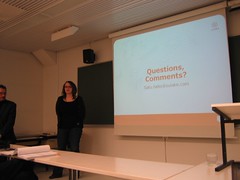
Discussion
Lisbeth: could be good to distinguish about goal making and decision making. Some things are intuitve. WoW - the machinima movies, about how to play your own world.
Craig: how fine applied goffmans theory, the frames, how could that be modelled for Larp..
//i think Marinka wrote about the fact that the Goffman theory rellay need to be understood from the environment where it was developed.... And what about that paper by ...dammit forgot name.
Harviainen: I wrote about that in a book that now is delayed!
Your approach is so clinical, and you are the most non immersionist player i have ever met, do you think the play resembles of religious ritual? The game state is so fundamentally different...
Heliö: even if we dont realise that we bring in stuff from the player it is there, that's how i see it but i know we will debate about this.
Pohjola: the characters want and need. Different. Conform in end of 2nd act. Could be a relevant distinctions.
Annika: It is a bit abstract, it would be interesting to see analysises of interesting failures.
Guy in blue t-shirt: these are the guileines given in forge!
Montola: player identity that affects character identity -> transformation and communication towards own goals.
Flood: Who is responsible? One bad apple can spoil it all.
Heliö: yes (with explication)
Mäyrä: challenges. Lack of role play in wow. What direction to go in online game design? Socially adjustable instances?
Heliö: Playful spaces, thats what im developing now workwise. Spaces with different types of actions availiable. The MMOGs has a gameness structure that is very difficult to work around. So we try to open it up.
Martin E: D&D online try a gamist approach to solve it. Own work with the posession model in Prosopoeia. As a player you have a ghost.
Heliö: interesting w the dynamics player -- character.
Martin E: yes milk out the drama out of it.
Flood: Role-Playing Games; The Theatre Game Theatre Forgot, freeform notes from Seminar on Playing Roles, Tampere
Flood: Role-Playing Games; The Theatre Game Theatre Forgot, freeform notes from presentation
Term role play coming from psycho drama.
Specific games to teach actors: theatre games. Developed 10 years before D&D was published.
Calls up 4 persons to the front.
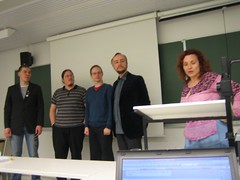
They are villagers. Trolls attack. Trolls are strong but dumb.
Roles: 1 villager, 1 troll, and 2 interpeters. Villager and troll cannot speak same language. Interpreters can verbalise the grunts.
Hilarous performance!
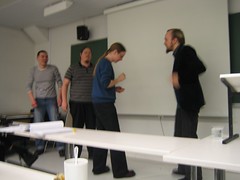
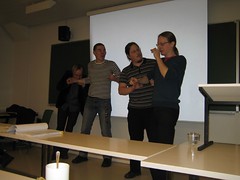
Discussion
Theatre games and role playing games are very alike, maybe similar?
Craig: but arent they fundamentally different, re having audience or not? Not ongoing process.
Flood: no audience in theatre games. Performance for the other participants. Byt yes, not ongoing.
Martin E: Maybe theatre forgot role players, but role players (at least in sweden) never forgot theatre. Reading and using existing thinking tools in impro. There is reciprocity efen if the people don't meet.
Flood: Interesting, first time in nordic context, In canada, US and Singapore, Asia the fields are very far away from each other.
Not bridged globally.
Stenros: this done a lot in swedish freeform. The description in the paper follows the public view on RPG, but when it is played it is very alike.
Annika: i did a profiling for LARP participant, a large part of them had theatre experience, but not table top or online rp experiences. Closer to theatre really. Different goals, they do it for the experience themselves, while in theatre the goal is to learn about acting. Different goal structures, for r players the experience itself is the goal.
Flood: but you can turn that around. Why is the the larp situation so different here?
Pohjola: role playig art, performance art, rp bordering that in 10 years or so. Americans call what we do impro theatre.
Flood: a lot of hack and slash in american larps. Frustrating for those who want to roleplay. Record: 3 characters in 10 minutes.
Staffan: check out dragonbane. Trying to define their way of rp, seeing differences from other styles and groups in europe.
Petri: Commedia del'arte?
Flood: histoic beginning. Resurfaced. Close tie. No role swiching.
Lisbeth: what direction now? Not only persistent character, aslo persistent universe. How performing differently re persistence?
Frans: TV series out of larp events. Boundary work. How record what happen to game characters? How make it attractive to an audience?
Flood: the now. The live thing.
Craig: misleading to generlise about role playing games, a lot of distinctions re motivations, play styles etc.
Flood: agree. Starting w big picture.
Martin E: imortant to remember difference between performance and immersion. RPs in north, a lot of them want the hotness, while cold acting might be more efficient for performancee.
Flood: no! Hot is better!
Martin E: Larp as theatre sucks as!
Stenros: Why did we swich roles?
Flood: all experience each role, illustrating for styles.






